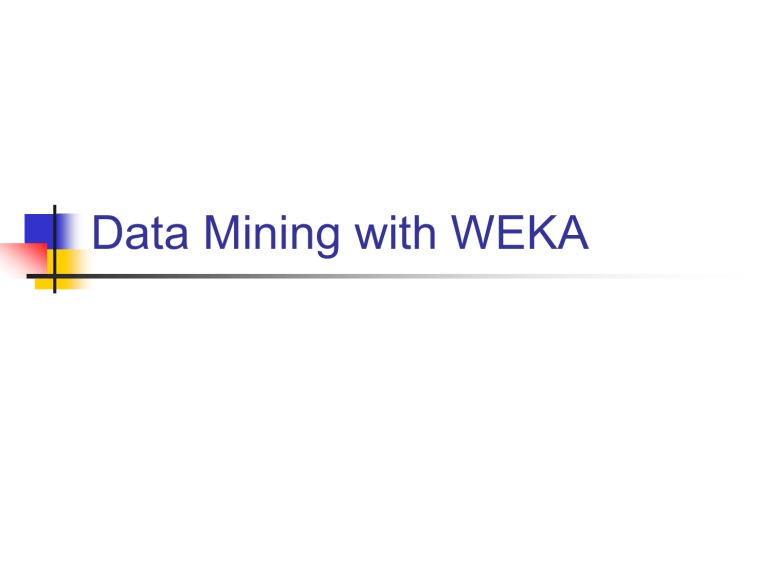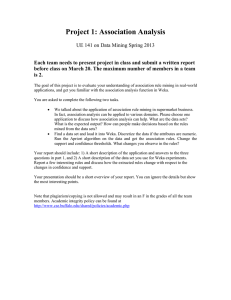
Data Mining with WEKA
WEKA
Machine learning/data mining software
written in Java
Used for research, education, and applications
Complements “Data Mining” by Witten & Frank
Main features
Comprehensive set of data pre-processing tools, learning
algorithms and evaluation methods
Graphical user interfaces (incl. data visualization)
Environment for comparing learning algorithms
Data Files
@relation heart-disease-simplified
@attribute age numeric
@attribute sex { female, male}
@attribute chest_pain_type { typ_angina, asympt, non_anginal,
atyp_angina}
@attribute cholesterol numeric
@attribute exercise_induced_angina { no, yes}
@attribute class { present, not_present}
@data
63,male,typ_angina,233,no,not_present
67,male,asympt,286,yes,present
67,male,asympt,229,yes,present
38,female,non_anginal,?,no,not_present
...
Explorer: pre-processing
Source
Data can be imported from a file in various formats: ARFF,
CSV, C4.5, binary
Data can also be read from a URL or from an SQL database
(using JDBC)
Pre-processing tools
Called “filters”
Discretization, normalization, resampling, attribute selection,
transforming and combining attributes, …
Explorer: building “classifiers”
Classifiers in WEKA are models for predicting
nominal or numeric quantities
Implemented learning schemes include:
Decision trees and lists, instance-based classifiers, support
vector machines, multi-layer perceptrons, logistic regression,
Bayes’ nets, …
“Meta”-classifiers include:
Bagging, boosting, stacking, error-correcting output codes,
locally weighted learning, …
QuickTime™ and a TI FF (LZW) decompressor are needed to see this picture.
QuickTime™ and a TI FF (LZW) decompressor are needed to see this picture.
QuickTime™ and a TI FF (LZW) decompressor are needed to see this picture.
Qu i ck Ti me ™a nd a TIFF (LZW)d ec omp res so ra re ne ed ed to s ee th i s pi c tu re.
QuickTime™ and a TI FF (LZW) decompressor are needed to see this picture.
QuickTime™ and a TI FF (LZW) decompressor are needed to see this picture.
QuickTime™ and a TI FF (LZW) decompressor are needed to see this picture.
Explorer: clustering data
WEKA contains “clusterers” for finding groups
of similar instances in a dataset
Implemented schemes are:
k-Means, EM, Cobweb, X-means, FarthestFirst
Clusters can be visualized and compared to
“true” clusters (if given)
Evaluation based on loglikelihood if clustering
scheme produces a probability distribution
Explorer: finding associations
WEKA contains an implementation of the
Apriori algorithm for learning association rules
Can identify statistical dependencies between
groups of attributes:
Works only with discrete data
milk, butter bread, eggs (with confidence 0.9 and support
2000)
Apriori can compute all rules that have a
given minimum support and exceed a given
confidence
Explorer: attribute selection
Panel that can be used to investigate which
(subsets of) attributes are the most predictive
ones
Attribute selection methods contain two parts:
A search method: best-first, forward selection, random,
exhaustive, genetic algorithm, ranking
An evaluation method: correlation-based, wrapper,
information gain, chi-squared, …
Very flexible: WEKA allows (almost) arbitrary
combinations of these two
Explorer: data visualization
Visualization very useful in practice: e.g.
helps to determine difficulty of the learning
problem
WEKA can visualize single attributes (1-d)
and pairs of attributes (2-d)
To do: rotating 3-d visualizations (Xgobi-style)
Color-coded class values
“Jitter” option to deal with nominal attributes
(and to detect “hidden” data points)
“Zoom-in” function
Performing experiments
Experimenter makes it easy to compare the
performance of different learning schemes
For classification and regression problems
Results can be written into file or database
Evaluation options: cross-validation, learning
curve, hold-out
Can also iterate over different parameter
settings
Significance-testing built in!
The Knowledge Flow GUI
New graphical user interface for WEKA
Java-Beans-based interface for setting up
and running machine learning experiments
Data sources, classifiers, etc. are beans and
can be connected graphically
Data “flows” through components: e.g.,
“data source” -> “filter” -> “classifier” ->
“evaluator”
Layouts can be saved and loaded again later
Conclusion: try it yourself!
WEKA is available at
http://www.cs.waikato.ac.nz/ml/weka
Also has a list of projects based on WEKA
WEKA contributors:
Abdelaziz Mahoui, Alexander K. Seewald, Ashraf M. Kibriya,
Bernhard Pfahringer , Brent Martin, Peter Flach, Eibe
Frank ,Gabi Schmidberger ,Ian H. Witten , J. Lindgren, Janice
Boughton, Jason Wells, Len Trigg, Lucio de Souza Coelho,
Malcolm Ware, Mark Hall ,Remco Bouckaert , Richard Kirkby,
Shane Butler, Shane Legg, Stuart Inglis, Sylvain Roy, Tony
Voyle, Xin Xu, Yong Wang, Zhihai Wang
